Mercedes-Benz E300 roadtest review: High-tech with tradition
/The latest iteration of one of the oldest model lines from one of the oldest car makers is now down to one mainstream choice, but still looks forward.
Read MoreThe latest iteration of one of the oldest model lines from one of the oldest car makers is now down to one mainstream choice, but still looks forward.
Read More
Base Price: $92,900
Powertrain and performance: 2.0-litre four-cylinder DOHC 16-valve turbocharged petrol engine. 165kW/5500-6100rpm, 350Nm/1800-4000rpm. All-wheel drive. Combined cycle fuel consumption 7.7L/100km (claim), 8.2L/100km (road test).
Vital statistics: Length 4634mm, height 1659mm, width 1834mm, wheelbase 2859mm. Luggage 565 litres. Wheels: 19-inch alloys with 235/50 R19 Continental PremiumContact6 SSR tyres (run-flat).
We Like: Driving position and visibility, five-seat family wagon space and occasional third row versatility. Brilliant multi-beam headlight technology, intuitive MBUX infotainment and control system.
We don’t like: Aggressive lane departure interventions, compromised access to third row seats.
THE alphabetic sequencing suggests the new Mercedes-Benz GLB sits one-size-up from models carrying the `A’ designation.
And the knowledge that Mercedes-Benz has built its new GLB on the same transverse engine platform as the latest A-Class hatch - and derivatives including the CLA, GLA crossover and B-Class - points to a compact definition.
But slot it into a car park and the GLB actually seems larger. So, I checked and compared.
Do you remember the W163 Series ML introduced in 1997 as its first Mercedes-Benz foray into SUVs beyond the mighty G-Wagen? The GLB has a wheelbase dimension 40mm longer than the ML and is also 47mm longer overall.
Width measures up at an identical 1834mm but the ML stood 116mm taller and that is where the impression of larger size is gained.
The debut of the GLB offers a family wagon solution between the GLA crossover and the GLC mid-size SUV with a spacious interior layout that includes three-row seating.
Pricing begins at $78,900 for the entry level GLB 200 (front-drive) version and the GLB 250 4Matic (tested here) is priced from $92,900. The step to the GLB 35 AMG performance model adds another $12K.

The 1991cc direct-injection petrol engine is a staple across multiple Mercedes-Benz model lines and powers the GLB 250 4Matic with 165kW available between 5500-6100rpm and peak torque of 350Nm across a wide 1800-4000rpm range.
And one more comparison to the old ML - the 2.0-litre turbocharged engine in the GLB 250 4Matic offers 5kW and 40Nm more than the 3.2-litre V6 from the late-90s.
Matched to the new eight-speed DCT dual clutch transmission there is readily accessible torque and close ratios to deliver relaxed highway cruising or a couple of quick downshifts and plenty of punchy response.
On the highway at 100kmh the GLB 250 4Matic settles at a long-legged 1500rpm in eighth gear or shifts to 1800rpm in seventh 2400rpm in sixth and 3000rpm for some fifth gear urgency.
It’s capable of the 0-100kmh sprint in a very respectable 6.9 seconds while a claimed combined cycle fuel consumption figure of 7.7 litres per 100km was nearly met by an 8.2L/100km road test average and a 7.2L/100km highway check.
A big part of the GLBs appeal is direct transfer of the intuitive technology introduced on the latest A-Class and since deployed across other Benz models.
That includes dual 10.25-inch displays with a configurable dash layout, the MBUX operating system with ``Hey Mercedes’’ voice inputs plus touchscreen, command controller and steering wheel haptic ``scroll and click’’ buttons providing multiple ways to interact with the GLB.
Where the GLB departs from the A-Class is its lengthened wheelbase, raised ground clearance and upright wagon styling. It’s a ruggedly stylish SUV with a purposeful stance, bold 19-inch alloy wheels and the detailing includes black roof rails and mirror housings.
The layout and dimensions make it a roomy mid-size wagon with the active lifestyle benefits of all-wheel-drive including off-road drive mode, boosted ground clearance, a powered tailgate that reveals 565-litres of load space plus a 2000kg braked tow rating.

One more skill in the GLB play book is the third-row seating and 5+2 accommodation.
It’s an occasional third-row suitable for younger children and going seven-up in the GLB requires clambering over the folded second row seats. And creating any useful footwell space means sliding the second-row well forward - although the front seats help with a deeply scalloped shape.
While the third-row falls somewhere between ambitious and occasional, the second row is a comfortable place to be when the GLB is configured as a five-seater. Generous shoulder width and only a moderate amount of centre tunnel intrusion combine with enhanced rear passenger visibility from a raised seat height.
The second row is configured with a 60/40 fore-aft slide mechanism and a 40-20-40 folding backrest. Installing the extra seating means a spare wheel isn’t carried and the GLB rides on Continental PremiumContact6 SSR run-flat tyres in a 235/50 R19 sizing.
The wide tyres provide surefooted feel on the road and once beyond the city limit, I liked the firmer suspension feel and reduced steering assistance offered in Sport mode.
The GLB proves easy to drive with a comfortable seating position including full power adjustment and memory functions for the front seats.
A check through the GLB model line-up reveals the step from 200 to 250 level brings more than increased output, one extra gear and 4Matic all-wheel-drive. The equipment list is also boosted with adjustable suspension damping, a panorama sunroof, heated front seats, shift paddles and carbon look cabin trim.
The test vehicle was optioned with the Galaxy Blue metallic paint ($1490) and three of the well-priced option packages including AMG Sports Package ($1990) including sports steering wheel and Sports Direct Steer while the Vision Package ($1190) adds a 360-degree camera display and the excellent Multibeam LED headlight technology.
The Driving Assistance Package ($1990) brings Active Lane Change Assist, Active Distance Assist cruise control and route-based speed adaption. The test vehicle priced up at $99,560.
Other standard technology content includes Traffic Sign Assist, multiple mini-USB charge points – including two in the second row and two more back in row three – and the 64-colour ambient lighting system.
The new GLB evolves the modern style and technology appeal of the latest A-Class and its follow-up derivatives with the addition of SUV capability and a generous increase in cabin space. The result is a strong new Mercedes-Benz contender in the fashionable medium SUV and crossover segment.
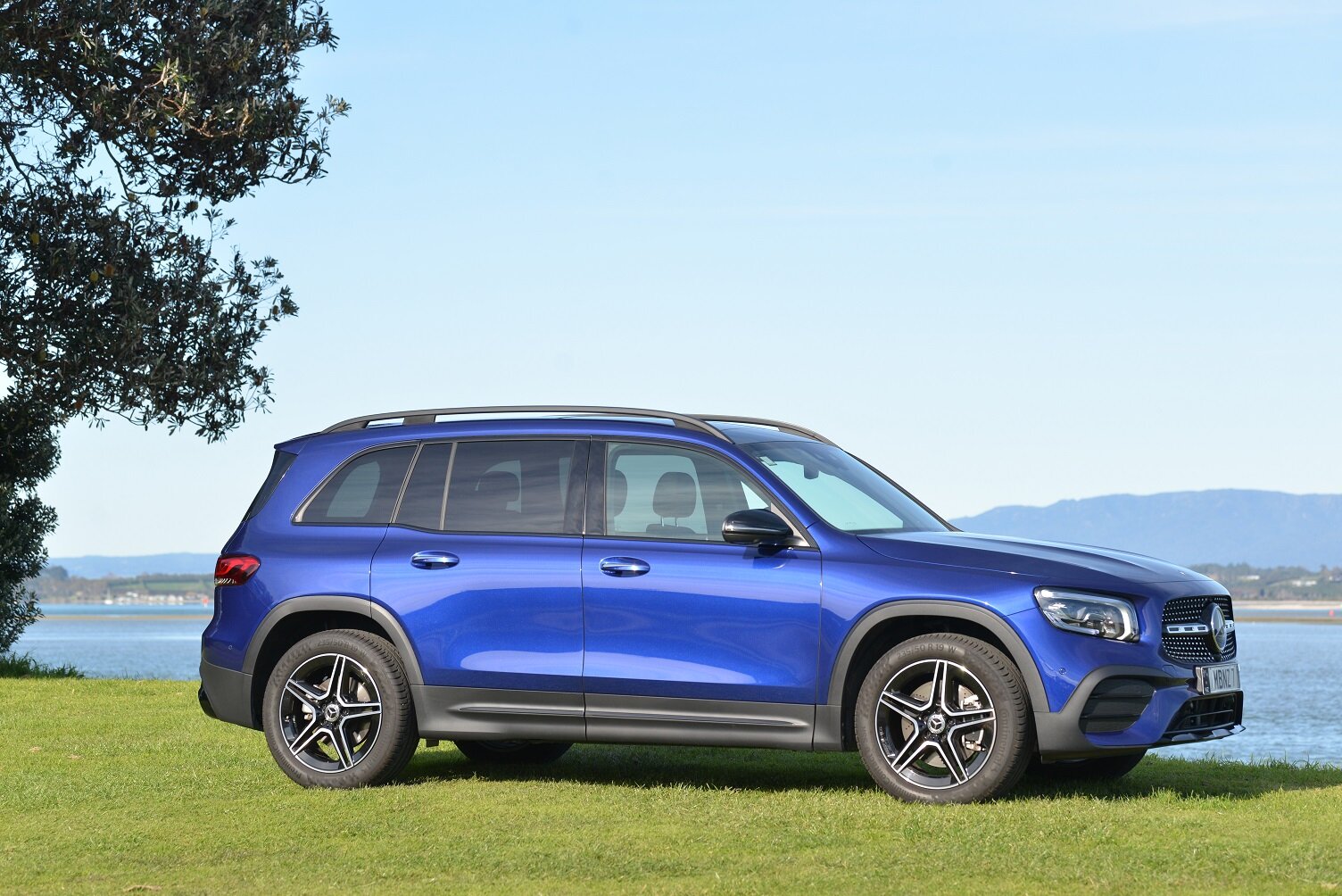
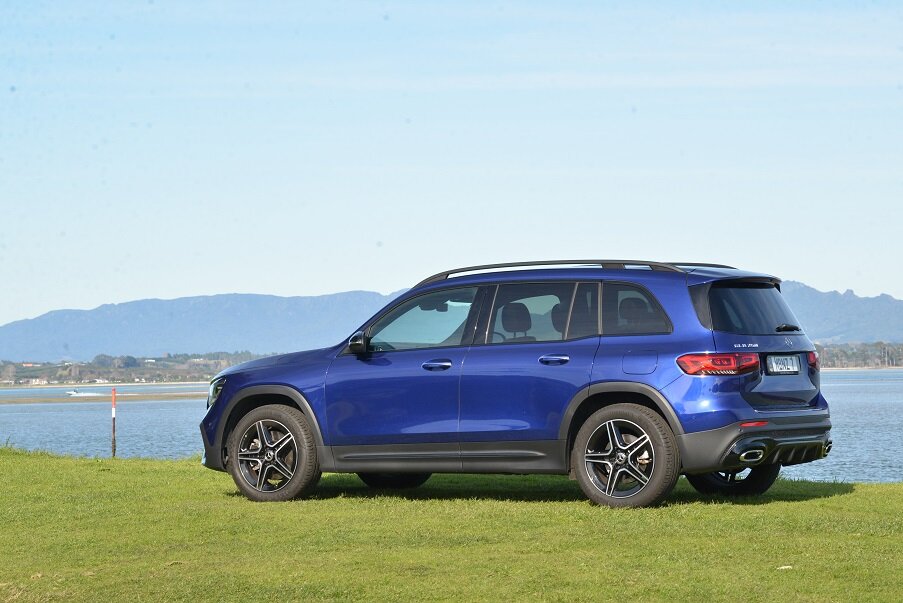
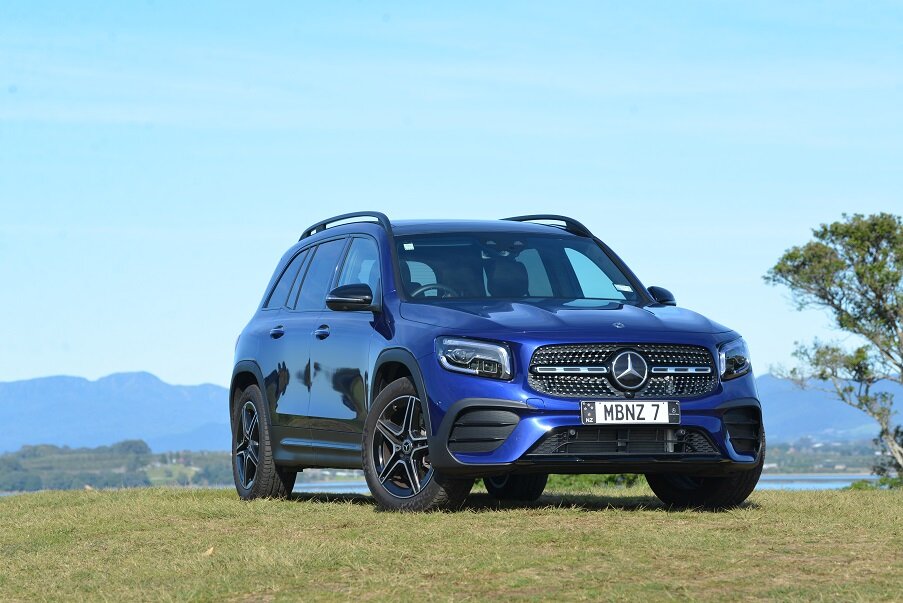
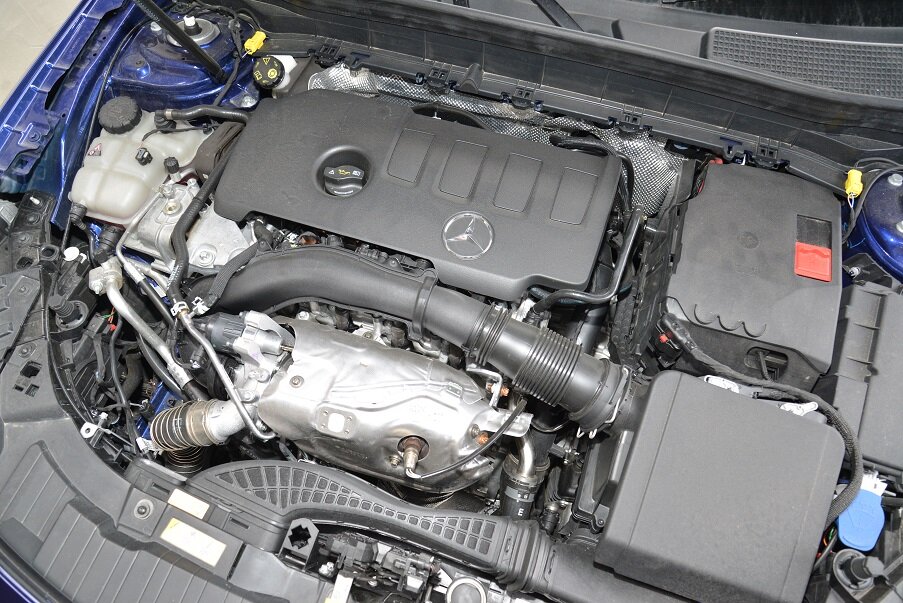
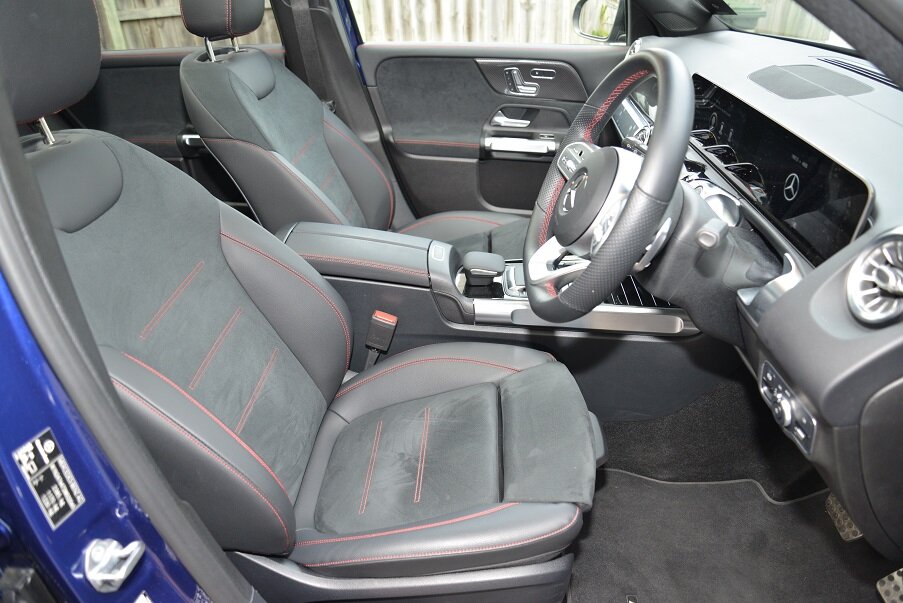

Base price: $92,900 (as tested: $99,560)
Powertrain and performance: 2.0-litre four-cylinder direct injection turbocharged petrol engine. 120kW/5500rpm, 350Nm/1800-4000rpm. All-wheel drive. Fuel consumption 7.7L/100km (claim), 9.2L/100km (road test).
Vital statistics: Length 4634mm, height 1658mm, width 1834mm, wheelbase 2829mm. Boot volume 565 litres. Wheels: 19-inch alloys with 235/50 tyres.
We like: Clever interior design, smart styling, tech-packed.
We don’t like: Column stalk shifter, solely configured for US-C, having to take sunroof to achieve best headlights.
IRREFUTABLE scientific fact: We’re taller than our ancestors.
The further back you go, the greater the differentiation, though some experts say in even just the last 150 years the average height of people in industrialised nations has increased approximately 10 centimetres.
Assuredly, then, were a troupe of Tudor troubadours to ever time-travel to today’s world, they’d likely consider the newest addition to Mercedes’ seven-seater sports utility family to be incredibly spacious, regardless that this latest opportunity is in fact the most compact yet.
Modern families? Well, even the most worldly would have to surely concur that, if considered purely on the merits of its seating plan, this is a car that is less tailored for the ‘everyday’ than it is for the ‘occasional.’
Don’t get me wrong. I’m not arguing this is a package driven by outright delusion. Quite the contrary. The label on this packaging doesn’t deceive. You’re quite probably looking at perhaps one of the most cleverly conceived products of this year.
Even with handsome Benz styling suggesting it as a big hatch, GLB is at heart a box full of chairs and the cleverness of the design and engineering of the interior is such that you truly wonder how a car so tight in its exterior dimension can be anything like as commodious. Brand testimony about GLB being specifically designed to be a seven-seater is not a truth stretch.
And yet, at same token, it’s built upon the platform also used by the A-Class, which is Benz’s smallest passenger model. So, even though the underpinnings have been stretched, and as useful as the full-blown format clearly is …. well, yes, the further back you’re assigned to sit, the tighter it becomes. If hardly for emergency use only, the third row pews are also obviously the most anti-adult.
So as much as a ton of very smart thinking (and using Volkswagen’s Tiguan Allspace for benchmarking) delivers decent head and legroom, excellent outward visibility and good stowage solutions, it’s all to a point. Running full occupancy, the luggage space remaining is miniscule and stowing the back pair (neatly, into the boot) and it becomes much more convenient.

Which means? Well, just this. You’re looking at a car designed for the realities of modern life. The one that can, if asked, carry the kids’ mates to soccer on Saturday morning as a last-minute favour because Rick’s best friend forgot to ask his dad about using their GLE.
And also the car that, later in the day when it’s in town on the shopping beat, is so much more convenient to slip through the traffic stream and slot into the last remaining decent park outside the supermarket because it’s just so much more sensibly sized than like-styled but far more substantial sister SUV.
Insofar as Mercedes’ sales plan goes, then, the GLB is quite a crucial car. It basically creates a new sub-category - there are virtually no direct rivals, certainly not from the prestige brands – and yet it also meets a known demand.
Small SUVs are hot. Given how its priced, specified and presented – in a 1.4 front-drive GLB200, the next step four-wheel-drive GLB250 on test here and an AMG edition, also all-paw, yet to land - Benz NZ conjects a significant customer call, core interest coming from families for whom this might well be their first new Mercedes. I cannot see how they can be wrong about that.
Thought of this being a ‘budget’ step into Benz SUV-dom needs taken with a certain degree of open-mindedness, all the same. There are plenty of brands of less premium nature than can provision significantly larger, more powerful vehicles for the money asked for this 2.0-litre edition, even before adding in the embellishments that featured on the tester.

Options of Galaxy Blue paint, an AMG sports package, plus driving assistance and vision packs – the first provisioning active cruise control, lane change assist, a more intelligent stop-start and ability to relay localised speed limits, the other delivering fully auto headlights in LED, a sunroof and the full parking assist (so, a 360 degree camera in addition to front and rear sensors) – pushed the car’s $92,900 retail to just $440 short of $100k.
Fortunately, there’s more than the sticker to remind you’re playing in premium territory. The car’s affluent look is abetted by a very upmarket feel. Impression gained from last year’s international launch about wanting to take care, before letting the kids in, to pre-check for sticky little fingers was all the cemented on this drive.
The flashiness extends beyond the fully digital dash with its MBUX interface (and over-eager ‘Hi Mercedes’ prompt). That a lot of the interior carries familiarity for those more used to the B- and A-Class is no slur.
This is a five-star model. Touch surfaces use high-quality materials, buttons and knobs have a satisfying tactility and reassuring clicks and it’s beautifully trimmed, with cushy seats.
This being the first Benz to come to us from a plant in Mexico does not impact on the sense of it being constructed to any lower standards than you’d expect from a German plant. The test car being blighted by a minor electronic annoyance that threw up occasional erroneous fault messages was no fault of the Aguascalientes assembly workers, but rather a duff chip in the transmission management computer. If it happens to you, rest assured a quick reboot will remedy all.
Starting off and concluding the test period with decent open road driving was a good plan. As much as the GLB delivers fantastic competence in urban use, it’s going to reassuring to know it’s not shy about taking on the open road.
Out in the 100kmh zone it straight away evidences quite a different feel to the rest of the compact car range, all the same. Whereas the other models on this platform tend to sacrifice outright comfort to elevate a sense of agility and sportiness, the GLB focus is more toward solidity and comfort.

Obviously, the car’s feel is dependent on which of the drive modes you select. Keeping in those better-suited to passengers – in other words, staying out of ‘Sport’ - delivers enough suspension pliability to soak up most ruts and bumps. Of course, this means allowing some concession for body lean in the corners, and the steering isn't the most precise, yet quite potentially the average GLB buyer won't notice or care. They’ll be more pleased about how planted and grown up it feels; the car has a wide stance and is on meaty rubber, but the 4Matic four-wheel-drive is also a good accomplice, regardless that is far from fulltime (to assist fuel saving).
What’s also quite appealing is that is doesn’t propose to be so wholly serious that it cannot evidence some sense of character. For sure, you’re not going to feel as compelled to dump the dog and kids and head off for a winding road in this version as you will with the AMG. But there’s no doubting that there’s a degree of talent, not least in the performance-tinged mode, that is worth tasting. The main difference in this comes with a sharper throttle response and elevated exhaust bark, but anyone wondering how much fun can be extracted by something so family-prioritised will surely raise a smile that the AMG 35 will turn into a full-out grin. On evidence of well it went on Spanish roads, that car is set to establish as something of a school run rebel.
The difference in performance between the AMG-ised edition and the 250 here is quite noticeable. A claimed 0-100kmh time of 6.9 seconds shows the 2.0-litre here isn’t lacking in spirit, but ultimately its talent is more aligned with delivering good economy and decent low to mid-range torque than to chase performance medals. With this in mind, you might pause to wonder if it always has enough snuff to keep itself together in family bus mode? I was unsuccessful in recruiting a full house of passengers for this test, instead having to settle for four adults aboard. Even that load was enough to take a little of the edge out of the engine’s oomph, though it did not seem to affect the powertrain’s refinement nor the fuel burn. Even when pushing up hills under load, it is a relatively inaudible and smooth unit. An average of 9.4 litres per 100km for the week was also fair, giving the driving it entertained.
The often-heard comment about SUVs being appealing simply on grounds that they offer good visibility has some relevance even in this scaled-down package. The upright design and highly adjustable driver's seat make it easy to see out of the GLB in almost all directions, and any blind spots are well covered by the sensors and the camera set.

The other appeal of this car is how it looks. As said, it’s clearly drawn a lot from the GLE (and even the GLS) but doesn’t look awkward from taking that approach. It also snuggles up quite nicely against the also-new Mercedes GLA, and though the GLB is taller, has a longer rear overhang and a much longer wheelbase it doesn’t appear at all awkwardly proportioned.
Coming back to where this story started, it’s understandable why Mercedes Benz here has only chosen the seven-seater edition for local distribution and ignored versions that come with five chairs.
Sure, I know from firsthand experience that the latter will deliver an even larger boot and so likely stand as an even more affordable alternate to, say, the GLC - which already looks very exposed by the GLB regardless.
But fact is, even though it is too tight to be considered as fully comfortable everyday proposition for full house operability, the seven-seater is a good choice on grounds of flexibility. The middle row slides fore and aft so you can apportion legroom between the passengers as needs be, while the seatbacks of the middle row adjust for tilt, too, and they can be folded down completely flat, just as the back pair can.
Beyond that, there’s plenty of industry evidence to suggest that even when used sparingly, this format is a smart buy in the sense that it'll be easier to sell on later.
What’s also interesting about GLB is where it will take Mercedes next. The brand has already expressed some interesting family expansion ideas. It’s now clear, also, that the wholly-electric EQB releasing internationally next year has drawn significant inspiration.
So, more intrigues to come from a car that already pulls surprises from the box.

Base price: $88,325
Powertrain and performance: 3.0-litre turbodiesel V6, 190kW/550Nm, 7-speed automatic, AWD, Combined economy 9.0 litres per 100km.
Vital statistics: 5340mm long, 1819mm high, 3150mm wheelbase, 19-inch alloy wheels with 255/55 tyres.
We like: V6 oomph and refinement, SUV-level driving.. We don’t like: Nissan base inhibits inclusion of best Benz tech.
Halfway up a dizzyingly ascent, the tough part – a narrow, steepening zig zag. It’s max attack or risk the consequences.
We’re tracking a Ranger Raptor, sensible spacing in event the desert rig stumbles. It doesn’t – and neither does our vehicle. All the way to the top.
Perception: The Mercedes X-Class 350d is easily the equal of a like-priced Baja-basher. Take that, Henry.
Reality? Well, ahem, it wasn’t as hard as it looked. Terrain untouched by rain for weeks afforded such great grip a BMW X3, on road tyres and driven by a bloke enjoying his first ever off-road experience, also ran the gauntlet. Still, nothing like answering the call of the wild, right?
Where exactly was this X-hit spot?
Rugged Manawatu farm country opened for a four-wheel-drive trek raising funds for Beyond Disaster Relief NZ, a Bulls-based non-profit that assists Pacific Island communities rebuild after natural disasters. They’re never short of work.
As everyone knows, the X-Class is a re-engineered Nissan Navara. Although Germany’s contention the V6 editions are more Merc than Nissan is a bit of a stretch, it’s certainly true that in ditching the original drivetrain for seriously sorted home-grown bits - ‘4Matic’ permanent all-wheel drive, a six-cylinder turbodiesel with a bespoke seven-speed gearbox, with various driving modes – they’ve departed significantly from the donor.

Fitted with all the trimmings - side steps, roof rails, a silver sports bar – the mica black Power tester was the epitome of $90k-ish designer ute big ka-ching bling. Everyone took to calling it the Death Star.
Why would you buy it?
Star appeal. It’s an extra-showy step away from convention with appealing hardware behind the ‘right’ badge.
Rich oomph makes the hauling easier, it sounds good and while placing second of the two sub-category contenders in the 0-100kmh sprint, that claimed time of 7.9 seconds is C200 sedan-compatible and represents a 4.4s reduction on the four-cylinder X-Class.
Some turbo lag doesn’t spoil impression of this drivetrain being a beautiful thing; torque peaking between 1400 and 3200rpm makes it almost as relaxed in the muck as when cruising. The transmission is a perfect partner, being nicely vroomy in a shift-sharpening Sport mode and offering paddleshifts, too. The all-wheel-drive factor is another rarity that instantly earns its keep; this provision – plus the 70mm wider track and enhanced suspension tune – make it a more confident, calming and captivating drive than any part-time ute.
It was so hugely effortless on the off-road course that the organiser’s request to run with the diff lock on was ignored. Simply enabling low range with its 50:50 torque split and the Offroad mode, which reprogrammes the gearbox and reduces throttle responsiveness, did the trick. ‘High’ (30:70 preference) was fine for gravel while on seal we snicked back in the baseline 60 percent rear axle bias.
Why wouldn’t you buy it?
Because even though the Merc miracle work delivers a great powertrain plus such a planted and supple road feel you’re left with impression this has to be one of the most SUV-like utes out there …. it’s not enough.
Yes, it’s impressive how they’ve redesigned and improved in a myriad of places, including the traydeck that, while still retaining those clever Nissan tiedowns is slightly better shaped. Beyond the brilliance of introducing the whole top part of a Benz issue dash with factory instruments, rounded vents and a pukka steering wheel, it gets all sorts of other tweaks, from a stronger chassis to a fuel cover release that operates off the central locking, rather than a cheap trigger.

Yet is all this and a rich spec - electric front chairs with upmarket (though synthetic) cloth/leather trim, a tyre pressure monitor, keyless go, aluminium and black fabric cabin inserts, a brilliant 360-degree camera that makes backing up to a trailer a cinch – enough to convince this is the most thoroughbred of workhorses?
No, because it’s impossible to ignore those aspects that couldn’t feel change for good yet, you suspect, would have had this been a wholly Merc exercise. A steering column lacking reach adjust, cheaper plastics below the beltline, unsupportive seats, lots of budget buttons and a tight back seat all remind that, at the end of it all, you’re still anchored to a donor that the market long ago determined was an also-ran to the category sales champs.
The stymying of what should be the opus feature, that floating screen controlled by Benz's Comand rotary dial, reveals how much compromise has gone on. Disappointment about it delivering an old-school functionality retired from almost all other Benz vehicles – so, two generations behind the swish MBUX that’s just gone into Sprinter van with its voice-controlled AI system - amplifies when discovering sat-nav slowness and flaky phone hook-up. It’s probable the electronic architecture Mercedes has to wire into is the problem. However, that won’t wash with a buyer base who simply expect better from a brand that trades on ability to deliver the best.
It does better meeting safety expectation with seven airbags (including side protection in the rear seats, unlike the Amarok), but even with class-uncommon aids of autonomous emergency braking, lane-keeping assist and park assist, it doesn’t quite tick all boxes, with blind-spot monitoring and adaptive cruise control off the menu.
Buy or drive by?
The X350d delivers an intriguing blend of ‘made better’ and ‘make do’. It has smart kerbside appeal and is better-sorted and more enjoyable than the four-cylinders.
And yet … well, I know the V6 Amarok is older, yet comparing with a like-priced Aventura reminds that, while the whole idea of a $90k ute is plain dopey, if you’re spending that big, it’s better to Dub step.
MotoringNZ reviews new cars and keeps readers up-to-date with the latest developments on the auto industry. All the major brands are represented. The site is owned and edited by New Zealand motoring journalist Richard Bosselman.